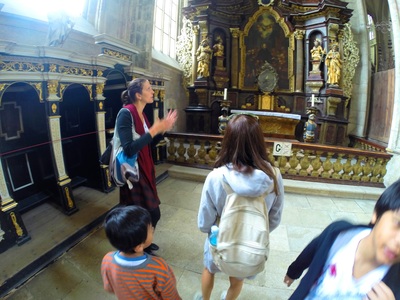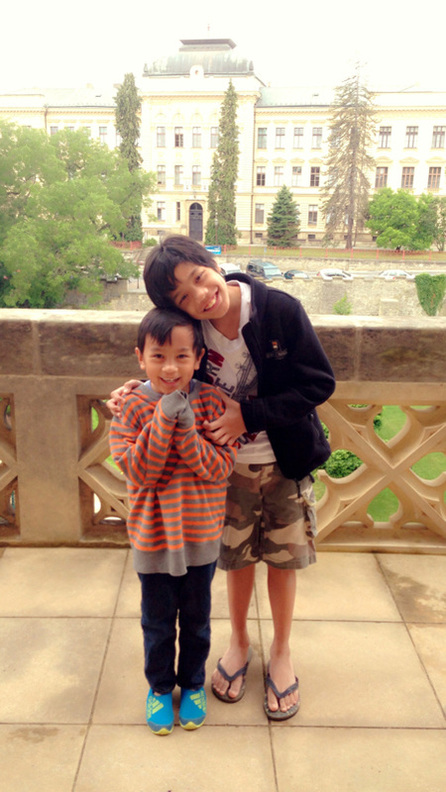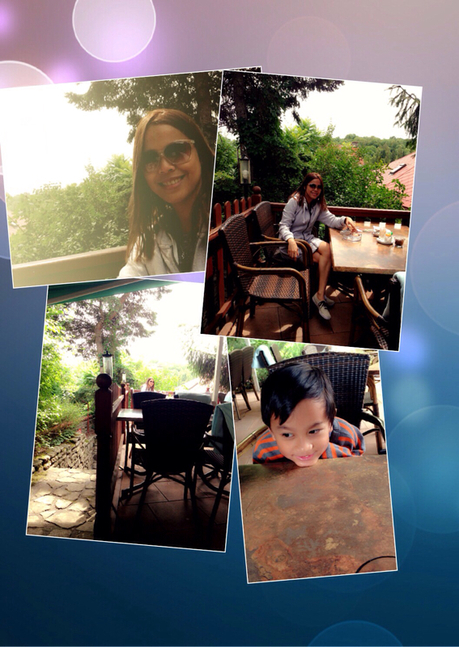The very first day of our out of town tour was a good one hour and half drive from Prague center. An hour and a half drive and the difference in the way of living is pretty massive.
It is still touristy, but take away the tourists? It really feels like time stood still here.
Kutna Hora started as a silver mining town. The silver rush happened and everyone in the guild settled wherever they can. There's no proper planning of town, it just happened.
We passed by their town center and it doesn't even feel it's the town center. All the effort and financing went into the churches.
The reason why Kutna Hora has so many churches for a pretty small town was because during the time of silver mining, miners understood their field as a very dangerous job. They can die anytime performing their work and they don't want to die without the last confession. So they asked for church to be easily accessible, they even financed some.
The trip was very educational, with a pre-tour video to watch for us and the boys while in the car en-route to the location. We also had fun-time with the boys as teams, having a friendly competition.
In this trip, we had to stick our hand in a pretty tight container and try to collect as many nuggets of gold (pretend) mixed with hay. It wasn't easy, Alex and I lost over Jason and Daddio. It is to show our boys how hard a miners' job is, adults learned it wasn't easy too!
The second competition for the day was throwing the gold nuggets within three plates, each has a value. Every time the team wins, we get minted coins which used to be the coin of the town. In the end, because to the total, Alex and I won over Daddio's team with Jason.
Our guide is Eva of Sightseeing Prague. She is amazing. Our tours were a mix of education, fun and relaxing moments. It's never too much of everything.
Email: [email protected]
Mobile phone: +420 728 880 367.
Website: http://www.sightseeing-prague.com/en
The skulls are real and they came from different places. Churches before used to have big cemeteries surrounding them, when the cemetery has to be trimmed down to a much smaller scale for hygienic reasons, the skulls and bones were used to decorate the church.
Another source were the war between Catholics and Hussites and of course the plague that hit Europe.
It used to be a working church, even before the skulls and bones were added. Nowadays it is a museum.
The idea behind the bone church is not to scare or shock people. The idea was more pragmatic during the conceptualization of the church's architecture.
It is a reminder that at the end of it all, we are all just skulls and bones. What matter is what you have done before you reach the end of your life. Everything in this life ends, so make it count.
It was freaky but my boys understood the reason behind the design and they thought it was pretty cool. Boys will be boys :)
The church residents believed that parishioners should't focus much on designs and distractions, but concentrate on prayers.
The highlight of this visit was when we were shown the loft. It showed how the vaults are held together. We walked the loft on the length of the church until we reached the balcony facing the altar on the other side. We also tested the natural acoustic of the church.
A solo singer can sing her heart out in that balcony and the whole church would be able to hear the song loud and clear.
An interesting shot was shown as well. One sunset in a year, during equinox, when the whole church is dark, the sunset's reflection goes straight into the altar, like a natural spotlight. Shame I didn't take a picture but trust me when you see it, it's awe-mazing.
The thought that comes into creating a surprise like that must be great. Because the altar is always on the east, they have to calculate at a particular time of day and season when will the sunset create a spotlight effect to the altar.
The faces are of course not real but the important bones like ribs, hands and feet are intertwined with the clothing are real.
It's also a gothic church but the most elaborate of them all. The spires, the flying buttresses!!! It's an enchanting church, inside and out.
The Cathedral was the miner's answer to the church of St. James. It is built by the hillside where the monastery's ownership ends. Supported financially by the miners, the original design was supposed to be bigger than what it is now. They wanted to show the Cisterian monks that they can do a more grandiose church design.
Though it's not as big as planned, it already is humongous even in today's standards.
You know how important the miners are during those days when you see designs, paintings or etchings on the walls that are miner-related and not religious or bible related.
It is a gargantuan structure indeed but what will make you feel so ordinary and small is the artistic flair that went into it, inside out. I would love to attend a mass in this church. It looks and feel so heavenly.
We then walk around town, leading up to an al fresco place for lunch. But before that, there are a lot of viewing point to enjoy this lovely town.
Streets are steep, houses are authentic, roads are cobbled, everyone is walking. Makes you think about period movies, ladies wearing traditional clothes walking back and forth in this road, bidding neighbors goodbye or greeting them hellos. Horses would be really useful in this road.
There was another church of St Nepomuk that has adam and eve on the facade which is unusual. Usually they don't adorn churches because their story is so basic, everyone knows about them, there is no need for a reminder. Because of this, this church is quite unique.
There is the plague post which we found in a lot of towns in Czech Republic. It's a symbol that once upon a time, this town was hit badly by the plague.
During those times, they create post because they believed that plague is a punishment for the evil deeds committed by the community.
Offering a post like it will show how much they are repentant and that they ask for their patron saint to heal them and help their town.
On top of plague monuments will always be Virgin Mary. Her devotion to helping us his children in her intercession to God and the triumph of prayers over plague.
In most of plague monuments is a Saint with a dog, always with his robe lifted showing his leg. It is St. Roch. His dog during his ailment, was the only one who comes close to him, bringing him bread to eat.
Something to find out.
Then... [click here to find out how our day ended...]


































 RSS Feed
RSS Feed
